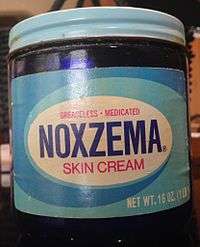Noxzema
Noxzema (/nɒkˈsiːmə/ nok-SEE-mə)[1] is a brand of skin cleanser marketed by Unilever. Since 1914, it has been sold in a small cobalt blue jar. Noxzema contains camphor, menthol, phenol and eucalyptus, among other ingredients. Originally developed as a sunburn remedy, it is frequently used as a facial cleanser and make-up remover. It can also be used for soothing chapped, sunburned, or otherwise irritated skin. Since the introduction of Noxzema, the brand name has appeared on shaving cream, razors, and skin-cleansing cloths.
 | |
| Product type | Facial Products |
|---|---|
| Owner | Unilever |
| Introduced | 1914 |
| Previous owners | Noxzema Chemical Company Noxell Corporation Procter & Gamble Alberto-Culver |
| Website | http://www.noxzema.com/ |
History
The original formula for Noxzema was invented by Dr. Francis J. Townsend (1875-?), a physician/druggist by 1900, in Snow Hill, Maryland; by 1910, in Berlin, Maryland; and by 1920, in Ocean City, Maryland.[2] The formula was called "Townsend R22" and referred to commonly as "no-eczema".[3] Dr. Townsend, who practiced near the beaches of the Atlantic Ocean, prescribed it as a remedy, mainly to beach resort vacationers who were severely burned by ultraviolet sun rays.
Townsend later gave the formula to druggist, George Avery Bunting (1870-1959), who for many years denied the transaction. In about 1917, Bunting began producing and selling "Dr. Bunting's Sunburn Remedy", marketing the product as an alternative to the greasy, tallow-based medicating creams in use during the period. For the first 3 years, George A. Bunting and Elizabeth Buck mixed, heated and poured the product themselves. The name was changed to Noxzema, supposedly because a satisfied customer who exclaimed, "Sure knocked my eczema!." An early slogan was “The miracle cream of Baltimore”.
Beginning in 1920, the cream was produced by Bunting. In 1926, Noxzema Chemical Company broke ground and built a small factory in Baltimore, Maryland at the corner of W. 32 St. & Falls Cliff Rd.[4] In 1926(Dec.14), N.C.C. applied for a trade-mark with the U.S. Patent Office.[5] By 1937, 15 million bottles were being sold yearly.[6] By the 1940s the product was being sold throughout the United States, and was promoted by radio and print advertisements. Noxzema continued to be produced by the Noxzema Chemical Company, which was reorganized in 1966 as Noxell Corporation, and was still under the ownership of the Bunting family.
In 1989 Procter & Gamble acquired the brand as part of the acquisition of Noxell. Alberto-Culver bought the rights to the brand in 2008 from Procter & Gamble and operated the line of skin-care products until Alberto-Culver was acquired by Unilever in 2010. In October 2014, the Noxzema brand in Greece changed its ownership from Procter & Gamble to a domestic company, Sarantis, for €8.7 million.[7]
References
- forvo.com Noxzema
- 1900,1910,1920 U.S. Census Records
- Patrick Di Justo (3 February 2015). This Is What You Just Put in Your Mouth?: From Eggnog to Beef Jerky, the Surprising Secrets of What's Inside Everyday Products. Crown/Archetype. pp. 229–. ISBN 978-0-8041-3989-2.
- The Anglo American 1938 Yearbook
- 1926 Index of Patents Issued from the United States Patent Office
- Life Magazine, Nov.29,1937
- "Sarantis announced the acquisition of Noxzema". Capital.gr. 9 October 2014. Retrieved 26 January 2015.